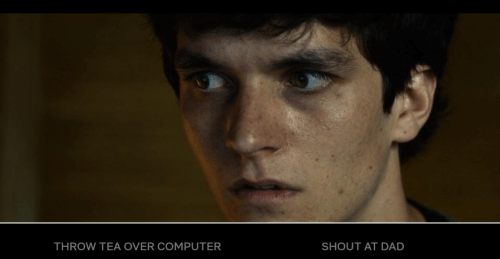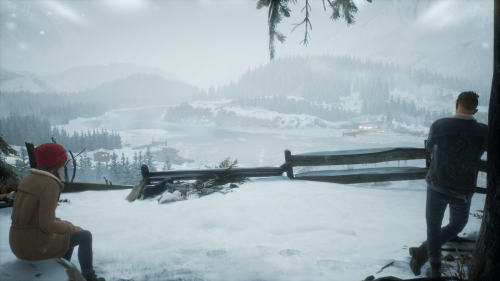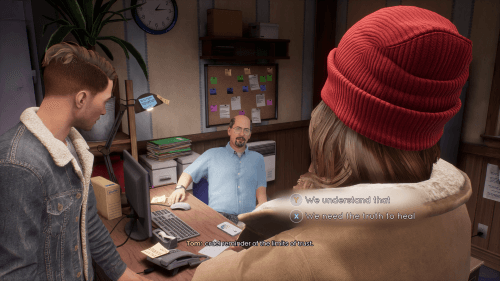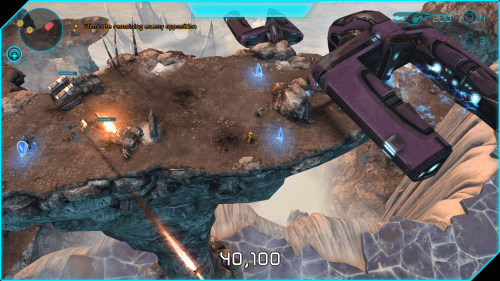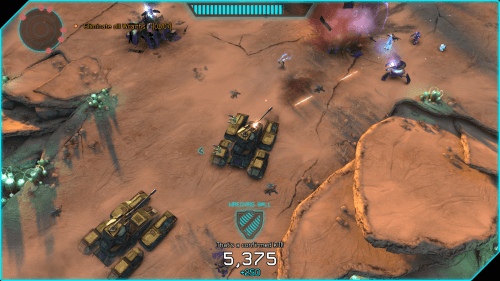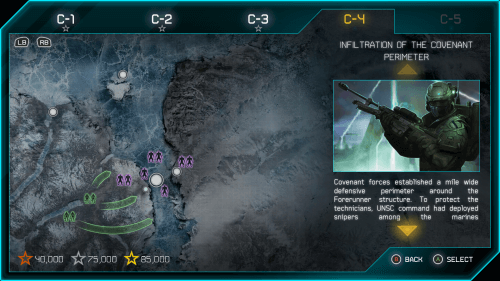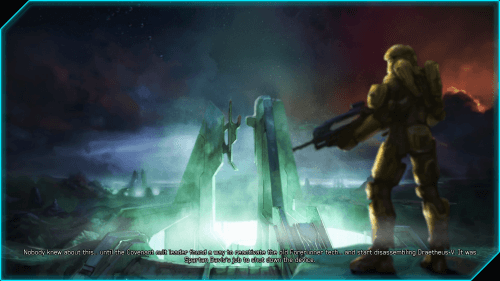Halo: Nightfall is a live action digital series that was released as part of the Master Chief Collection in late 2014 as a promotional tie-in with Halo 5. I’d never seen Halo: Nightfall and knew only the scantest details about it before watching the feature length movie version for this post. While the parallels with the previously covered Halo: Forward Unto Dawn should be obvious, Nightfall feels a lot more like a legitimate movie that was chopped up to make a series than a series of separate shorts that were edited together to make a movie and, despite having similar budgets, Nightfall also features a lot more effects, more notable actors, and was produced by legendary filmmaker Ridley Scott’s production company. It’s certainly equally as ineffective as a tie-in to the game it is associated with, though!
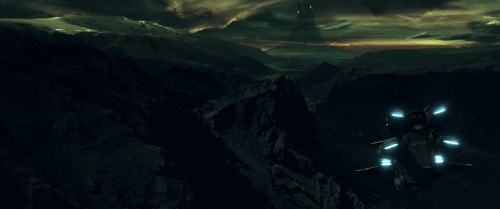
“Alpha Halo, a little worse for wear after Master Chief’s visit.”
That is, Halo: Nightfall was supposed to be something of an origin story for Jameson Locke who we’d come to know as Spartan Locke, one of the main characters featured in Halo 5. The problem is that by the time we meet Locke in Nightfall he’s already pretty much the same character we get to know in-game, and while it’s not a bad introduction to him, we definitely learn a lot about who he is in the sense of his personality and values, there’s not much else there, nor is the overall story significant to the plot of the game either. That said, since it is a side story let’s just dive right into spoiler land! Skip next two paragraphs if you want to avoid a somewhat vague plot summary and some random but specific nitpicks.
The Story: Lieutenant Commander Jameson Locke and his four-man Office of Naval Intelligence team operating on the colony world Sedra track an Elite Zealot to the center of Sedra City where it detonates an unknown device. The device unleashes a never-before-seen element deadly to humans, resulting in a large number of casualties. Investigating, the ONI team discovers that the Elite acquired this element from smugglers who harvested it from a semi-intact fragment of Installation 04. Orbiting close to a sun, the ring fragment’s surface reaches extreme temperatures when directly facing it, making only short visits during its night cycle possible. Locke and his team devise a plan to head to the fragment, arrest any smugglers they locate, and, as it’s believed to be the sole source of the element, destroy it with a Havok nuclear warhead. The team is granted use of a slipspace capable Sedran Colonial Guard ship to make the journey, but only under the condition that they’re accompanied by members of the Sedran military. Arriving at the fragment, the joint team quickly locates the smugglers but are attacked by a swarm of Lekgolo, killing several of them and downing their ship before they can extract. With no way to call for help and only the smugglers’ small ship left intact, the team decides to complete their mission and journeys on foot to retrieve the warhead. With their numbers dwindling as they’re pursued by the Lekgolo, the group eventually has to shed most of their technology when they learn that the Lekgolo can track them by it. With time running out of time and desperation setting in, Locke’s remaining two agents take the rest of the team by surprise, taking a hostage and making their way back to the ship to save themselves. With few options left, the commander of the Sedran team, Colonel Aiken, a former SPARTAN-II who lost his only child to the terrorist attack, volunteers to manually detonate the warhead while Locke and Macer, the only other surviving Sedran soldier, attempt to intercept them. The pair reach the smugglers’ ship just in time to witness the Lekgolo finish off the last of them and swarm the now powered-up ship. Aiken begins to activate the warhead, drawing the Lekgolo away and giving Locke and Macer the window they need to board the ship and escape the fragment before it is obliterated.

“Locke, James Locke. Our protagonist.”
While we’re told Sedra is surrounded by conflict and that the Sedrans have this archaic warrior culture (err, they still believe in Valhalla?!) we’re shown exactly none of this. Maybe this was a budget thing, but then why mention it at all? The almost constant tension between the ONI agents and the Sedran soldiers felt more than a little contrived and I found Colonel Aiken’s over-the-top combativeness to be especially unbelievable, even if it is explained by his backstory. Speaking of which, I really don’t buy him as an ex-Spartan. Furthermore, even knowing his backstory, Aiken wanting to sacrifice himself due to losing his daughter is a little lame for reasons I feel best described towards the bottom of this lengthy (and otherwise much more positive) article by Haruspis. Also, why in the hell was getting the Havok right then and there so damn critical? Why not just get out of dodge now and destroy the fragment later? The sad part is that I think the premise of the story actually works on paper, and while it might not have been an amazing Halo movie, it could have at least been much more entertaining if executed differently.
Thankfully most of my issues with the execution are wrapped up in those kinds of details. While some of the CGI is pretty bad, the majority of the practical effects, costumes, and props are quite excellent. The actors are all also mostly good despite being betrayed by the script a bit, with a pre-Luke Cage Mike Colter giving a typically solid performance as Locke. Another likely budget related letdown is the rather boring filming location in the latter part of the movie. While I get that the place they’re at is supposed to be destroyed, I can’t help but imagine how cool it would be if it resembled the games more closely. Speaking of the games, the soundtrack is another letdown. I’m sure it’s fine, but I literally remember nothing about it, and that really isn’t good enough for a game franchise whose soundtrack has always been a huge part of the formula.
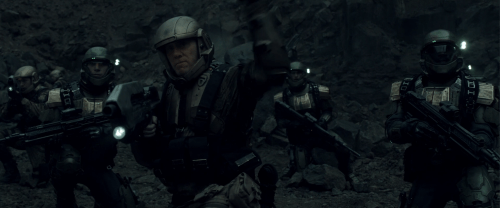
“The combined team on the fragment. Love those ODST helmets!”
I feel like I’m being quite negative here, but Halo: Nightfall isn’t that bad. It’s entertaining enough to watch through once, sure, but it earns the “entirely skippable” I tagged Spartan Assault with and then some. In fact, unless you’re really curious about it and/or just have to consume everything Halo related, I’d suggest skipping it. At least I still liked Locke by the end of it so maybe that at least bodes well for my playthrough of Halo 5 when I eventually arrive there. Maybe? In any case, like Forward Unto Dawn before it, Nightfall still fails to deliver on a strong effort to make Halo a crossover success. At this point our only remaining hope is the 2022 series, and skepticism already abounds about that one.
A quick extra mention goes to the “Second Stories” bonus content that was released on the Halo Channel as something of an in-universe version of the after-episode shows that have been popularized with some of the bigger television series in recent years. While these shorts do contain interesting details that help fill in some gaps in the story, I can’t say they impressed me much. Still, they’re definitely a very notable but easily missed part of Nightfall.

